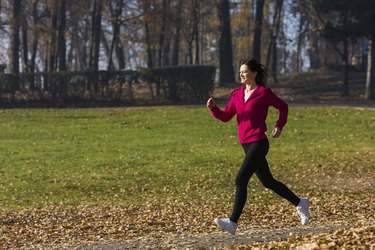
It wasn't long ago that the only reason someone over 30 ran was to catch a bus; if you were 50 or older, well, you'd just wait for the next bus. Exercise for so-called seniors was in the form of either bowling or golf. Today, however, running — on purpose — is a recommended way for 50-year-olds to get in shape and stay in shape. New approaches to running and programs geared to ease you into running have leveled the running landscape, making it as easy for a 50-year-old to start running as it is for a twentysomething.
Before You Start
Video of the Day
It's standard advice before starting any exercise program, but especially pertinent if you're 50 or older: Consult a physician before diving in. By the time you hit 50 you may have acquired a health risk or two — heart, lung or joint issues, for instance — or experienced a major disease. If that's the case, your doctor may have specific recommendations for you related to running. Even if you're relatively healthy, your doctor may suggest easing into the activity with a walk-to-run program.
Video of the Day
Walk-to-Run Programs
The walk-to-run approach to running was pioneered in the 1970s by Jeff Galloway as an injury-free way to train for a marathon or half-marathon. The concept is simple: slowly introduce your body to the notion of running by interspersing periods of walking with running. Begin by walking more than you run, then gradually change the equation until you're running more than walking, and finally just running. Since the mid-2000s, the concept has been adopted for shorter running programs, in the form of so-called couch-to-5K programs.
Born to Run
Christopher McDougall was tired of hearing doctors tell him the only way for him to avoid his persistent running injuries was to stop running. He embarked on a quest to find a different answer, a quest that wound up with a book, "Born to Run," which sparked a running boom after its publication in 2009. One of his key findings was that the heel-strike style of running, championed during the running boom of the 1970s, was causing all sorts of problems. Instead, he found, we should run as we did eons ago, as we hunted down wildebeest on the Serengeti: landing on our forefoot, allowing the multitude of bones to absorb the shock. The advice has been especially helpful for older runners with sensitive joints.
Alternative Running Styles
Other changes to the way we run have been advocated by various running programs over the past decade. Chi Running, for instance, promises injury-free running by promoting shorter strides, letting gravity help you on the downhills, engaging your core as you run, leaning forward slightly, relaxing your limbs, and landing on your midfoot. The style is intended to minimize the stress to the body often associated with running, which is especially appealing to older runners whose bodies may be more susceptible to the rigors of running.